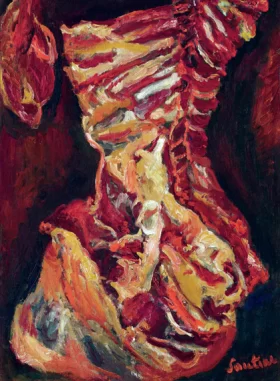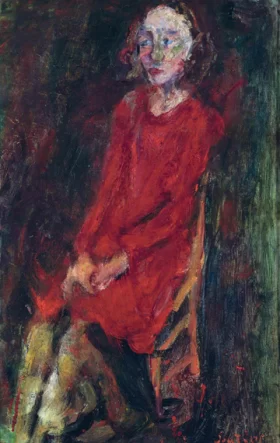只今全作品5%Off!! チェックアウト時にこのコードを入力してください!KMJP5
只今全作品5%Off!! チェックアウト時にこのコードを入力してください!KMJP5
シャイム・スーティン
Chaïm Soutine (13 January 1893 – 9 August 1943) was a Belarussian painter whose highly individualistic style, characterized by the use of thick impasto, agitated brushwork, convulsive compositional rhythms, and the presence of disturbing psychological content, is closely related to early 20th-century Expressionis, while living and working in Paris.
Soutine was born Chaim-Iche Solomonovich Sutin, in Smilavichy in the Minsk Governorate of the Russian Empire (present-day Belarus). He was Jewish and was born the 10th child of a poor Jewish tailor in Belorussia. At age 16 he went to Vilna (now Vilnius) in Lithuania, where a friendly doctor helped him attend the school of fine arts for three years. In 1913 he emigrated to Paris, where he met Marc Chagall, Amedeo Modigliani, and Jacques Lipchitz, and attended the École des Beaux-Arts.
For a time, he and his friends lived at La Ruche, a residence for struggling artists in Montparnasse where he became friends with Amedeo Modigliani. Modigliani painted Soutine’s portrait several times, most famously in 1917, on a door of an apartment belonging to Léopold Zborowski, who was their art dealer. Modigliani introduced Soutine to the art dealer Leopold Zborowski, who enabled him to spend three years (1919–22) painting at Céret in the south of France. The feverish, visionary landscapes Soutine painted there marked the emergence of his mature style.
Zborowski supported Soutine through World War I, taking the struggling artist with him to Nice to escape the possible German invasion of Paris. After the war Paul Guillaume, a highly influential art dealer, began to champion Soutine’s work. In 1923, in a showing arranged by Guillaume, the prominent American collector Albert C. Barnes, bought 60 of Soutine’s paintings on the spot. Soutine, who had been virtually penniless in his years in Paris, immediately took the money, ran into the street, hailed a Paris taxi, and ordered the driver to take him to Nice, on the French Riviera, more than 400 miles away.
Soutine is most popularly associated with his studies of choirboys and cooks and his series of pageboys notably “Page Boy at Maxim’s,” 1927. Also well known are his paintings of hung poultry and carcasses of beef, which convey the colour and luminosity of putrescence. He obtained these effects by painting in as many as 40 different hues with as many brushes.
Soutine spent most of the remainder of his life in Paris. He exhibited little during his lifetime and relentlessly reworked or destroyed old canvases, but his paintings nevertheless found their way into French and American private collections and museums.
Suffering from a stomach ulcer and bleeding badly, he left a safe hiding place for Paris for emergency surgery, which failed to save his life. On 9 August 1943, Chaim Soutine died of a perforated ulcer, during the wartime German occupation. He was interred in Cimetière du Montparnasse, Paris.
In February 2006, an oil painting of his controversial and iconic series Le Bœuf Écorché (1924) sold for a record £7.8 million ($13.8 million) to an anonymous buyer at a Christie’s auction held in London—after it was estimated to fetch £4.8 million. In February 2007, a 1921 portrait of an unidentified man with a red scarf (L’Homme au Foulard Rouge) sold for $17.2 million—a new record—at Sotheby’s London auction house. In May 2015, Le Bœuf, circa 1923, oil on canvas, achieved a record price for the artist of $28,165,000 at the Christie’s curated auction Looking forward to the past.
結果の1~100/322を表示しています

Le Bœuf 1923
By シャイム・スーティン¥57,429
L’homme au Foulard Rouge 1921
By シャイム・スーティン¥59,709
Le Bœuf écorché (Carcass of Beef)
By シャイム・スーティン¥68,049
Le petit pâtissier 1927
By シャイム・スーティン¥50,609
Pastry Cook of Cagnes (Le pâtissier de Cagnes) 1922
By シャイム・スーティン¥55,159
Pastry Cook with Red Handkerchief
By シャイム・スーティン¥56,669
The Pastry Chef (Baker Boy) (Le Pâtissier) 1919
By シャイム・スーティン¥55,159
Le Petit Pâtissier (The Little Pastry Cook) 1921
By シャイム・スーティン¥83,229
Bellboy 1925
By シャイム・スーティン¥54,399
Le Garcon Detage 1928
By シャイム・スーティン¥52,879
Portrait of a Boy 1928
By シャイム・スーティン¥58,949
Le Valet de Chambre
By シャイム・スーティン¥68,049
Le Valet de chambre 1927
By シャイム・スーティン¥63,499
Le valet de chambre 1927 1
By シャイム・スーティン¥67,289
Le Maître D’hôtel 1927
By シャイム・スーティン¥53,639
Le Garçon d’étage
By シャイム・スーティン¥55,919
Le chasseur de Chez Maxim’s 1925
By シャイム・スーティン¥49,849
Page Boy at Maxim’s
By シャイム・スーティン¥73,359
Femme à la poupée
By シャイム・スーティン¥54,399
La femme entrant dans l’eau 1931
By シャイム・スーティン¥63,499
La Communiante (La Mariée) 1924
By シャイム・スーティン¥67,289
Femme au parapluie 1942
By シャイム・スーティン¥62,739
La Femme en rouge
By シャイム・スーティン¥58,189
Woman in Pink 1924
By シャイム・スーティン¥56,669
La Femme en rouge au fond bleu 1928
By シャイム・スーティン¥57,429
La femme en rouge sur fond bleu
By シャイム・スーティン¥61,219
Le grand chapeau 1923
By シャイム・スーティン¥61,979
Woman in Red
By シャイム・スーティン¥55,159
Jeune Femme en rouge 1929
By シャイム・スーティン¥62,739
Femme en rouge assise sur un banc
By シャイム・スーティン¥50,609
Woman with Round Eyes (La Femme aux yeux ronds) 1919
By シャイム・スーティン¥54,399
Butcher Boy
By シャイム・スーティン¥52,879
Woman in Red Blouse 1919
By シャイム・スーティン¥55,919
The Idiot 1920
By シャイム・スーティン¥60,469
Child with toy
By シャイム・スーティン¥54,399
Mad Woman 1920
By シャイム・スーティン¥63,499
Portrait de Madame X (Portrait Rose) 1919
By シャイム・スーティン¥52,879
La Jeune Anglaise
By シャイム・スーティン¥52,129
La sieste (Femme étendue sous un arbre) 1934
By シャイム・スーティン¥55,159
A Dreaming Girl
By シャイム・スーティン¥55,159
Jeune Servante (Waiting Maid, also known as La Soubrette) 1933
By シャイム・スーティン¥51,369
La Polonaise 1928
By シャイム・スーティン¥50,609
Le Chasseur
By シャイム・スーティン¥55,919
Éva 1928
By シャイム・スーティン¥53,639
La vieille dame assise 1924
By シャイム・スーティン¥60,469
La Vieille dame au chien 1919
By シャイム・スーティン¥58,949
Portrait d’une dame 1928
By シャイム・スーティン¥53,639
Portrait de femme de face 1929
By シャイム・スーティン¥53,639
Portrait of a Woman 1929
By シャイム・スーティン¥56,669
Portrait of Madeleine Castaing 1929
By シャイム・スーティン¥57,429
Portrait of Maria Lani 1929
By シャイム・スーティン¥53,639
La Fillette en Robe Bleue au Col Rouge
By シャイム・スーティン¥74,119
Portrait of a Boy 1928
By シャイム・スーティン¥53,639
La femme accoudée
By シャイム・スーティン¥53,639
Portrait De Jeune Fille (Paulette Jourdain) 1928
By シャイム・スーティン¥50,679
Young Girl in Red Blouse (La Petite fille en rouge) 1919
By シャイム・スーティン¥52,879
Woman in Blue (La Femme en bleu) 1919
By シャイム・スーティン¥65,019
Portrait d’une jeune fille (Fille en blouse bleue) 1937
By シャイム・スーティン¥58,189
La Folle 1918
By シャイム・スーティン¥53,639
Girl in Blue
By シャイム・スーティン¥62,739
La cuisinière (Femme en bleu) 1935
By シャイム・スーティン¥74,879
Portrait Young Man
By シャイム・スーティン¥55,919
La Femme au col rouge 1929
By シャイム・スーティン¥50,609
Girl in Green
By シャイム・スーティン¥55,159
Portrait of the Sculptor, Oscar Miestchaninoff
By シャイム・スーティン¥56,669
La folle
By シャイム・スーティン¥56,669
Garçon d’honneur
By シャイム・スーティン¥53,639
Gypsy
By シャイム・スーティン¥53,639
Woman in Profile 1937
By シャイム・スーティン¥65,779
La Servante en bleu 1934
By シャイム・スーティン¥49,099
La femme au chien 1917
By シャイム・スーティン¥57,429
Jeune homme obliquement étendu
By シャイム・スーティン¥51,369
Man in Blue (L’Homme en bleu) 1921
By シャイム・スーティン¥74,879
L’Homme au Chapeau
By シャイム・スーティン¥74,879
Portrait of Moïse Kisling
By シャイム・スーティン¥58,189
Portrait d’un jeune homme
By シャイム・スーティン¥60,469
Portrait d’homme (Émile Lejeune)
By シャイム・スーティン¥52,879
Woman Seated in Armchair (Femme accoudée au fauteuil) 1919
By シャイム・スーティン¥58,949
Young Woman in a White Blouse (Jeune femme à la blouse blanche)
By シャイム・スーティン¥56,669
La Liseuse Endormie (Madeleine Castaing) 1937
By シャイム・スーティン¥58,189
Femme couchée 1940
By シャイム・スーティン¥67,829
Le Garçon en Bleu
By シャイム・スーティン¥56,669
Woman in blue dress 1924
By シャイム・スーティン¥56,669
The Little Girl in Pink 1923
By シャイム・スーティン¥58,189
Girl in Pink, 1925
By シャイム・スーティン¥57,429
Le jeune homme au petit chapeau 1916
By シャイム・スーティン¥65,019
Deux enfants
By シャイム・スーティン¥58,949
Le nain rouge
By シャイム・スーティン¥58,189
The White Hat (Le Chapeau blanc) 1923
By シャイム・スーティン¥61,979
Portrait de Charlot
By シャイム・スーティン¥52,879
La petite fille à la poupée 1925
By シャイム・スーティン¥53,639
Young Girl with a Doll
By シャイム・スーティン¥55,159
Le petit garçon 1934
By シャイム・スーティン¥57,429
Enfant de chœur
By シャイム・スーティン¥54,399
Choir Boy 1925
By シャイム・スーティン¥55,159
L’enfant de choeur 1927
By シャイム・スーティン¥65,019
Maternity 1942
By シャイム・スーティン¥52,129
Portrait Of A Man With A Felt Hat 1924
By シャイム・スーティン¥55,919
The Green Dress 1922
By シャイム・スーティン¥58,949
The Woman at the Chair 1919
By シャイム・スーティン¥68,049




































































































